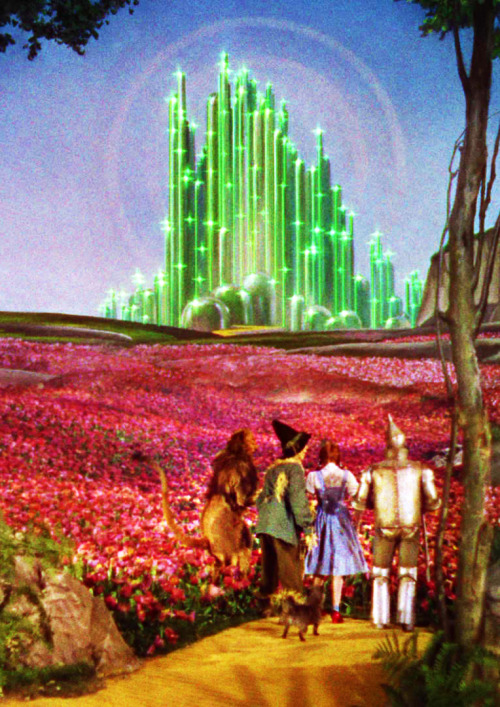How many fantasy authors do you suppose started writing because of L. Frank Baum’s The Wonderful Wizard of Oz? Like me, they probably reached the last page and couldn’t bear to let the story go. Or maybe they goggled at how much the book differed from the movie, and wanted to reconcile the gap. Whatever the reason, many probably started writing because Oz opened a door they never knew anyone had closed.
Esteemed editors Adams and Cohen collect several authors to put their own spin on literature’s most famous magic land, and its most famous heroine. Some of the authors are celebrities in their own right, like Orson Scott Card, Jane Yolen, and Seanan McGuire. Others are niche authors or up-and-comers, whose words say more than their names. All share an obvious enthusiasm for the classic story, and bring a range of insights with them.
Dorothy’s adulthood makes a recurring theme. Seanan McGuire presents a grown, disillusioned Dorothy, fallen from Ozma’s graces, investigating a murder in the land where nobody dies, in “Emeralds to Emeralds, Dust to Dust.” Simon R. Green’s “Dorothy Dreams” features Dorothy’s waning days in a rest home. Theodora Goss’ “Lost Girls of Oz” features Dorothy as Ozma’s military commander, preparing to invade that ancient enemy: America.
Some of these stories even skip across genres. David Farland’s cyberpunk vignette “Dead Blue” and Tad Williams’ “The Boy Detective of Oz” are both science fiction, the latter building on Oz themes in Williams’ slipstream Otherland novels. Ken Liu’s “Veiled Shanghai” retells the classic story as an allegory of China’s May 4th Movement, in which Chinese youth took a stand against European imperialism and Beijing’s feeble indecision.
May I add: Wow.
Some of the best stories remain true to Baum’s original narrative, adding to the story or presenting some other way of seeing it. The stories bookending this collection, Rae Carson & CC Finlay’s “The Great Zeppelin Heist of Oz” and Jonathan Maberry’s “The Cobbler of Oz” serve as prequels, helping explain how Oz became the powerful but confused land Dorothy first discovers. The former is primarily funny, the latter sad and touching.
 Some of the most interesting suggest that something bigger is happening behind the scenes of Baum’s original novel. Rachel Swirsky’s “Beyond the Naked Eye” reveals that Dorothy’s quest was really part of a rigged reality TV show, while Dale Bailey’s “City So Bright” tells the tale of the nameless workers who keep the Emerald City looking so pretty. Both declare that, below the shiny surface, long-unspoken desires threaten to boil over into insurrection.
Some of the most interesting suggest that something bigger is happening behind the scenes of Baum’s original novel. Rachel Swirsky’s “Beyond the Naked Eye” reveals that Dorothy’s quest was really part of a rigged reality TV show, while Dale Bailey’s “City So Bright” tells the tale of the nameless workers who keep the Emerald City looking so pretty. Both declare that, below the shiny surface, long-unspoken desires threaten to boil over into insurrection.These stories bring an important “view from the bottom” often missed, not only in Oz, but in fantasy altogether. We easily forget that fairytale kingdoms and Neuschwanstein-esque castle confections rely on battalions of workers to oil the gears. Part of the transition to adulthood involves reconciling the romance of the top and the reality of the bottom. As such, these stories may hang closest to Baum’s original fantastic intent.
As is common in current “grown-up” literature, some of the stories run toward cynical nihilism. Jeffrey Ford’s “A Meeting In Oz” features a grown Dorothy finding that adulthood did not agree with her, locked in a staredown of mutual recrimination with a paunchy, despondent Wizard. Kat Howard’s “A Tornado of Dorothys” tells of a magic land trapped in eternal recurrence, plagued with ghosts and hungry for another Dorothy to consume.
Not to speak poorly of these stories. The most cynical generally also show the greatest depth. My favorite, Robin Wasserman’s “One Flew Over the Rainbow,” presents the famous wandering quartet as psych ward inpatients. It’s bleak and gloomy (the story owes more to Girl, Interrupted, than the implied source), but it has the book’s most humane and touching denouement. Just be warned: read too many of these stories in a day at your own peril.
Out of fifteen stories, I’d expect one anticlimactic letdown. Seldom have I been so happy to see my expectations thwarted. These authors keep the twists, insights, and unique viewpoints on a well-known story coming at us. Though sometimes inappropriate for small children, these stories build on the sense of childlike wonder that never quite goes away.
As Orson Scott Card’s “Off To See the Emperor” implies, Oz remains at hand. Just because we don’t see it doesn’t mean it isn’t there. Alternately smart, tragic, funny, surprising, and insightful, these stories reaffirm why Oz remains fundamental to American childhood: because it addresses us where we are, affirming that our own stories matter.

No comments:
Post a Comment